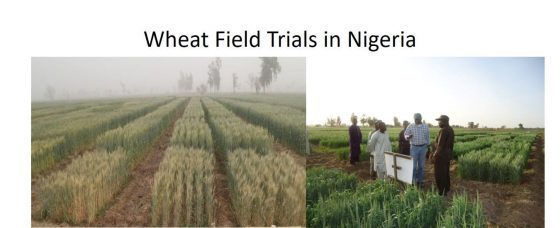By Aymen Frija, ICARDA —
In the framework of the R&D SARD-SC project funded by the AfDB, and as part of the Global Futures & Strategic Foresight program, the ICARDA foresight team recently used the IMPACT model used to assess the effect of the adoption of improved wheat management and areas expansion (AE) on the aggregated performances of wheat sectors in selected Sub-Saharan African countries (Ethiopia, Sudan, and Nigeria) under different climate change (CC) scenarios. Results were presented at the International SARD-SC wheat conference in Abuja, Nigeria on 27th February to 2nd March 2017.
While the demand for wheat in SSA depends on many economic and income growth variables, the supply of the commodity will mostly depend on closing the yield gaps and expanding current areas devoted for wheat production. In the 1960s, average cereal yields in Africa were about 57% of the world average (FAO data). This gap was widening until the 1990s with an average value of 42%, and stabilized at that level since then. On the other side it is estimated that a potential area of 200 million hectares could be converted to rain fed agriculture in SSA, of which 95 million hectares could be accessible without major investments in infrastructure. This area is roughly estimated as being 45% of the total area in the world suitable for wheat expansion. Expansion of wheat areas is possible through two approaches: 1) further expansion of agricultural land through conversion of suitable rangelands and forest areas; and 2) through the adoption of improved heat tolerant wheat varieties that can be suitable for cultivation under new agro-ecological areas in SSA. Ethiopia, Sudan, and Nigeria, were considered for investigating the scope and impact of these options on reaching wheat self-sufficiency.
Specifically, the simulated scenarios combine options of CC to technology change (TC) and area expansion (AC). TC scenarios assume a logistic adoption function of improved wheat technology until reaching 50% of the total wheat area in respective countries by 2025. AC scenarios also assume gradual expansion of wheat areas to a certain extent (different from one country to another) until 2025.
Results show an important potential for increasing wheat production and decreasing imports in the three considered countries. Particularly, Ethiopia and Sudan have the possibility to fully cover their domestic consumption through local production and stop importing wheat, under some of the simulated scenarios. Ethiopia could stop importing wheat by 2019 (4 years after the reference year 2016) under a first scenario suggesting a combination of 1843 thousand ha of total wheat area, and an average yield of 2.55 tons/ha, which could be achieved by adopting enhanced wheat management practices and improved varieties on 17% of the total wheat areas. Ethiopia could also reach self-sufficiency of wheat by 2025 by combining an average yield of 2.33 tons/ha, which is the yield which might be obtained under the Business as Usual scenario (0% adoption rate), and a total cultivated area of 2282 thousand hectares.
For the case of Sudan, self-sufficiency of wheat would only be possible by 2023 (8 years after the reference year of our scenarios: 2016) under the optimistic scenario combining “CC, TC, and AC”. This scenario suggests an increase of wheat area in Sudan up to 573 thousand hectares, combined to an average yield of 3.8 tons/ha, which might be obtained by adopting improved wheat management practices on 43% of the wheat area.
For Nigeria, none of the simulated scenarios would allow reaching wheat self-sufficiency. This is mainly due to the high domestic demand of wheat in this country (which in turn depends on the high population) as well as the limited wheat area in the country, even when we assume large expansion. However, Nigeria could cut its wheat imports by 50% if it widely increases wheat area up to 890 thousand hectares and adopts improved wheat management practices on 50% of these areas.
Another important finding of this study can be drawn from the case of Ethiopia, which shows that area expansion of agricultural commodities does not necessarily involve large public investments but can be achieved through appropriate price instruments backed by effective market institutions, especially in relation to improved seeds marketing. In fact, many high yielding, drought and heat tolerant wheat varieties have been generated by the SARD-SC project during the last 5 years and were proven to have a good impact on productivity increase in the selected countries. However, making such varieties available at a larger scale for farmers remains a real challenge. By improving wheat productivity, and guaranteeing wheat prices, the area elasticity to yield will certainly lead to higher cultivated wheat areas in many SSA countries, which will in turn result in lower importations.
More details on this study will be available soon in a paper that is being prepared for publication in 2018.






